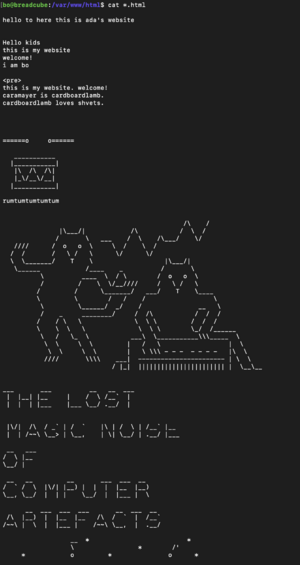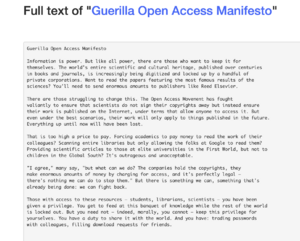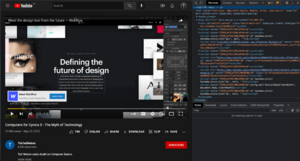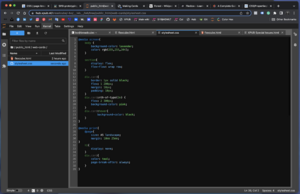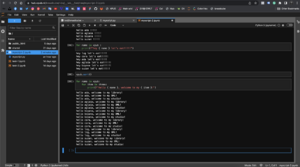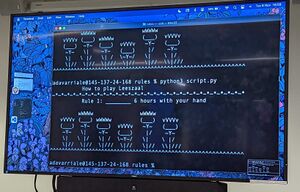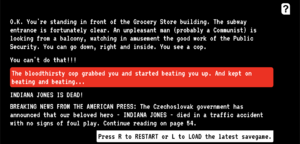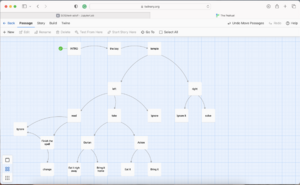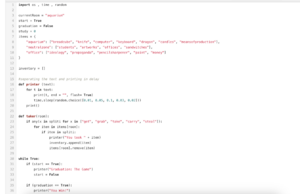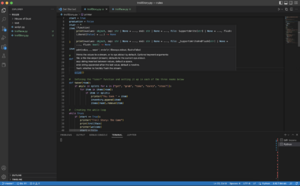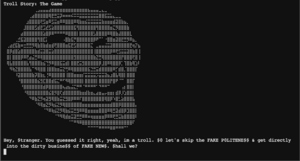User:Bnstlv/prototyping: Difference between revisions
| Line 386: | Line 386: | ||
[[File:Troll Story- The Game.png|thumb|right]] | [[File:Troll Story- The Game.png|thumb|right]] | ||
Morning | Playing text adventure games w/ Joseph<br> | Morning | Playing text adventure games [w/ Joseph]<br> | ||
It was fun to play again and discuss the (new) games we coded in the last week, and it was nice to see so much progress for such a short amount of time. With only a few sessions of learning about python, everyone is able to code their own game or adjust an existing one and tweak it to their liking. It was great to see the variety of storylines, directions and approaches each of us took. It brings new perspectives to the table. Also, grateful to Steve for sharing with me his work, course I am also interested in using JSON with Python. | It was fun to play again and discuss the (new) games we coded in the last week, and it was nice to see so much progress for such a short amount of time. With only a few sessions of learning about python, everyone is able to code their own game or adjust an existing one and tweak it to their liking. It was great to see the variety of storylines, directions and approaches each of us took. It brings new perspectives to the table. Also, grateful to Steve for sharing with me his work, course I am also interested in using JSON with Python. | ||
| Line 392: | Line 392: | ||
Afternoon | Spaghetti code w/ Manetta<br> | Afternoon | Spaghetti code [w/ Manetta]<br> | ||
Today, she was explaining how can we use [http://introtopython.org/classes.html#Making-multiple-objects-from-a-class classes in python], and their different implementations and see cases. At some point, she shared this funny story of programmers calling long pieces of code a "spaghetti code". It made me laugh, fun facts :) | Today, she was explaining how can we use [http://introtopython.org/classes.html#Making-multiple-objects-from-a-class classes in python], and their different implementations and see cases. At some point, she shared this funny story of programmers calling long pieces of code a "spaghetti code". It made me laugh, fun facts :) | ||
Revision as of 20:47, 31 January 2023
Prototyping 01 Breadcube and The Web
Our server was born on Sep 20, 2022! We called it breadcube. During our first Prototyping session, we talked a lot about Sandbox, Debian, and Unix-like systems, and went through some of the basic terms, commands, and syntax, like Shell Cheat Sheet:
- bo@breadcube:~$ whoami - bo@breadcube:~$ cd .. - bo@breadcube:/$ ls - bo@breadcube:/var/www/html$ nano bo.html and more
Manetta and Joak also showed us some figlet art. :)
_ - __ ___ __ _ _| |__ - \ \/ / '_ \| | | | '_ \ - > <| |_) | |_| | |_) | - /_/\_\ .__/ \__,_|_.__/ - |_|
- _ _ _
- | |__ _ __ ___ __ _ __| | ___ _ _| |__ ___
- | '_ \| '__/ _ \/ _` |/ _` |/ __| | | | '_ \ / _ \
- | |_) | | | __/ (_| | (_| | (__| |_| | |_) | __/
- |_.__/|_| \___|\__,_|\__,_|\___|\__,_|_.__/ \___|
Prototyping 02 The Internet. Mark up text
Pad: the internet, the web, mark up that text
During our second Prototyping session, we invited our breadcube to join the XPUB HUB. To do that we used Tinc, and followed all steps described here XPUB HUB New Nodes. Breadcube is on the HUB!
TIL:
- Pads are private and can be used for private notes. Wiki Pages are public (-ish);
- XPUB HUB is the only server that could be accessed freely via the internet;
- Up arrow - to go back to previous commands, history of commands;
- the $ is for Bash language;
- the # is for commands to the root;
- they both ($ and #) indicate to us that are waiting for our command;
- the "man" command stands for "manual" and gives us detailed instructions on how and what the specific command can do for us (ex: man cat; mac ls; etc.);
- the /root folder is a secured folder with restricted access, so only people with the right rights can change it;
- our folders are not protected, each one of us can access, change and even delete (lol) them;
- bashrc - to go back to the home folder
- sudo is a permission group; a group of people like all of us from xpub1
- drwxr-xr-x
- rwx = user
- rdw = group
- rwx = others
Prototyping 03 Jupyter, HTML, CSS
During the first half of the day, we explored the Jupyter Notebook app, its interface, functions and capabilities. Later, we dug into the world of HTML and CSS.
-“Technology is packaging and conventions.” "iPhone is not technology, but packaging and conventions." - by Ted Nelson
Links mentioned during class:
- Documentation by Mozilla
- Guerilla Open Access Manifesto by Aaron Swartz
- FROM New art form based on the Internet technology. 1997. Project by Alexei Shulgin.
- Hyperworld (the 2022 edition) Hyperlinking done by XPUB1
TIL: Jupyter Notebook
- Notebook - a specific space where you can write both code and text
- Text files - to turn them into HTML files just rename the file by adding .HTML at the end
- Under "Other" there are several options to choose from: open a Text file, open the Terminal, and more.
- Navigating inside the File browser:
- choose “+” sign to open a new Launcher tab
- choose “folder+” sign to create a new folder inside the directory where you are
- choose “up arrow” to upload files inside the folder we are working
- “shared” folder -> folder on our server used to share content (our pages on the breadcube)
- on shared/html - is where the breadcube page is located;
- /index.html - is our homepage.
- Shift + Enter to execute a command
- Shutting down Jupyter - it runs in the background even if our tab is closed. So to shit it completely we need to go to the "Running Terminals and Kernels" (the circle with a square inside) and select Shut Down All and Close All.
TIPS:
- use the "man" (manual) command to find out what a specific command can do, a guide on how to use it and type in the Terminal or on Jupyter
- put always borders with strong colors around the elements to see better the changes you are making
TIL: HTML
- <!DOCTYPE html> - convention; tries to render the page even if there are small errors (like missing special character encoding), unlike python. It will load the page and automatically try to fix the errors.
- css - always goes into the <head>
- head - here we put everything regarding the structure of the content
- body - here we put the content itself, like text, images, embedded videos, etc.
FUN STUFF TO CLICK ON (AND EXERCISE):
- Flexbox
- The frog game
- A Guide to flexbox
- The garden game
- Exploring CSS 3D Transforms
- Stop the counter!
Prototyping 04 Styling and Web-to-print
Our fourth prototyping session explored HTML and CSS capabilities in more detail. We talked a lot about styling and what CSS can do for us when building a webpage. It was enjoyable to see how animations and transitions are created, look at some very cool examples and even give it a try:
- My First Webpage
- Black and White Transition - transition from one state to another & animation
- Color Transition - using keyframes
WEB CARDS
At the end of the first half of the day, we managed to create web cards, style them and make them ready to print. First, we structured the content itself in HTML by adding a title and body (head - section - div - class). Then, we moved to CSS and added borders, colors, margins and paddings, and played with the hover effects and flex-flow wraps. We did that in the .css file, the @media screen and @media print snippets.
SVG and ANIMATIONS
During the second half of the day, we dived into SVG and SVG animations. SVGs are very cool because they are light, responsive and flexible! Manetta and Joak showed us how we can draw in Inscape, export the drawing in SVG and then animate it within the code editor.
SVG and text are familiar in terms of CSS manipulation. When we style a text we think of its typeface, font size, color, etc. We apply the same principles when styling an SVG file by changing its stroke, fill, color (hex code, RGB), opacity, and so on.
Useful links when styling webpages:
- CSS Colors; HTML Color Codes; Colorhexa
- font families in CSS
- character set
- guide for flex boxes in CSS
Prototyping 05 Python
- Python 🐍 is a programming language that lets you work more quickly and integrate your systems more effectively. (Wikipedia)
Python 🐍 is powerful... and fast;
plays well with others;
runs everywhere;
is friendly & easy to learn;
is Open.
These are some of the reasons people who use Python would rather not use anything else.
Source: python.org
Today I started my journey in programming. I have only heard of Python but never worked with it. I'm curious to find out what can I do with it since it is a multipurpose language - from machine learning and data science projects to web, mobile and desktop development, automation and more. It was designed by the Dutch programmer, Guido Van Rossum more than 20 years ago.
After the installation, we kicked off the sessions with basic calculations, syntax and simple commands. By the end of the day, we were able to build our own code which let us generate the HTML code for the new set of web cards.
* Useful links about Python:
- Python Documentation contents - it looks overwhelming :)
- Module Index
- Beginners Guide for Non-Programmers
Trying out Python for the first time!
Inside Python, we started playing around with the content derived from Alison Knowles's work - House of Dust. Alison is an American visual artist known for her installations, performances, sound works, and publications. More about her here
What I did during the exercise was to replace the existing list of words in the .py file with new ones which I selected from the House of Dust text. As a result, the programme generated a new, somewhat senseless yet fun sentence, i.e. combinations of words and phrases, like this one:
A HOUSE OF INTERPRETATIONS
ON AN ISLAND
USING CUCUMBER
INHABITED BY PEOPLE WHO ENJOY SINGING TOGETHER
Then, I decided to follow the 'gardening' theme and add words like 'PRUNING', 'COMPOSTING', 'FERMENTING', 'TILLING', 'FERTILISING', etc. and what happened after performing the "print()" command was also very funny. Here you can see my version of A house of plants:
FERMENTING
MEANS WAVING
BY USING MUSHROOMS
DONE BY WARRIORS, BUGS AND OTHER INSECTS.
TIL:
- In programming "0" = 1 and -1 is the last in a list or string.
- True & False - The Python Boolean type is one of Python's built-in data types. It's used to represent the true value of an expression. For example, the expression 1 <= 2 is True, while the expression 0 == 1 is False. Understanding how Python Boolean values behave is important to programming well in Python. Not only in Python I would say, but in life in general too.
- What is GIT - version control software
- Git VS GitHub - makes it easier to collaborate using Git; a platform that can hold repositories of code so multiple developers can collaborate on a single project and see each other's edits in real-time; publicly available; social coding. Owned by Microsoft.
- GitHub VS GitLab - a similar platform. like GitHub, GitLab enables you to store code and use Git version control capabilities. Can speed up the workflow.
- Python can be used for text processing - very nice demonstration by Manetta with a piece of the texts I wrote in the pads.
Prototyping 06 Git and Open Source Code
We read a few paragraphs from The Cathedral and the Bazaar. Joak also mentioned Eric Raymond
Creating our first repository on Git.
- Download and install the Git-scm
- We clone part of the repository onto our Great Pumkin Patch
- Tasks while being inside the repo:
- git add README.md (this file contains "hello world!" text) - git commit -m"README.md" - git push (to push it on the remote server) - these steps Joak did - git pull (we will pull the README.md file to our local server) - we did this one - $ git add filename (to add a new file to the stage, we do it manually, it's a task, not a command) - $ git commit -m"README.md" - $ git pull (to have it on my local machine) - I edit the content of the README.md file that Joak made, and changed it from "Hello World!" to "Hello XPUB!". Saved it and then - gut merge (to merge the files that were in conflict) - git push ls - git status
I had some issues installing it because of the Ventura macOS update. But we solved it by installing Xcode. See GIT Osx Installer
Creaating our repository for the SI19.
We created our 'coming soon' page for the SI19 here
We had a Midpoint Meeting during which we discussed what we have produced so far, the cards, how can we build upon them and further develop the system, what we need to do in the next 5 weeks until the release date.
Takeaways from today’s meeting:
- in general, there is a confusion, it's too open
- at first, for someone who does not know the context, the deck of cards creates a certain expectations, one of an actual garden, *but it is recognised as a card game
- so maybe our metaphor* is not clear enough? maybe we need to make it more explicit?
- how can we make the ‘garden of knowledge’ metaphor more understandable, seeable within the deck
Cards
- cards are seeds, prompts, invitations for conversation
- what if the cards are not the outcome but a tool for making something (a pathway from A to B)
Context
- have the libraries and librarying in mind and find ways to use the cards as a system, a tool to come up with an output
- "What happens when you look at library from the point of view of gardening?"
- 'Gardening' - A a new vantage point to libraries
- how cards can help us (or someone else) produce something, or solve problem, reach to a conclusion, or else
- What-How-Why model
- decide what is our WHAT? a webpage, a device that prints out cards, a deck of cards, a starter pack, an experience, or a mix of several things?
- the cards might be our HOW? our methodology
- what is our WHY? the intention before starting the game or implementing the system to solve an issue
Audience
- who is our audience? get to know them better
- document the experiences and first impressions cards create in other people (outside of our process)
- Library = Conversation
- library = knowledge (history + memory, where history = news, facts, while memory = ideas, abstract concepts, identity)
- knowledge = exchange of news and ideas
- exchange of news and ideas = conversation
- do we have a name for our system/game?
- for example “the chat bubble cards” if libraries are seen as conversations
- idea in development: the chat bubble (chat cube?) webpage where anyone can enter definitions to print our cards under specific topic (action)
Next
- meet tomorrow at 15h (XML, studio) to play and test things out
- check also devices there
- meet on Thursday at 10h (Leeszaal) and explore the space, talk with the people there, try to play with the cards
- create a space to log things, document the process
- meet next Monday in the Social Practice Library
- would be great if we have an intention/idea prior to the visit
- assignment for next week (on zulip)
- readings for next week (also on zulip)
- for next Tuesday have a list of ideas we want to try out during the prototyping session
Some thoughts and notes about the big picture thinking, our toolkit and more ideas: https://pad.xpub.nl/p/SI19-20221014
Prototyping 07 Weaving texts together
List of ideas for prototyping
- Gardens like the ones I saw in Observable
- Cards = Rules to manipulate text (via python script)
- Text processing/manipulation like in the Unfold Project
- Build a prompt page, simple like this one - verse & light installation
- Awwwards Interaction & Web Examples
- Retro style loading animation
- Website Elements Kit
We talked about Computers of the Art, a book by Dick Higgins, and the process of Permutation. After that, Stephen suggested generating the rules for our card games using a python script.
0 = the first -1 = the last -2 = the one before the last
We switched the "hot seat" and each of us did something in python. As a result, we generated our rules by writing code collectively. Many pushes, pulling and conflicts followed, but we made it in the end.
Here is a snapshot of a version that we pulled of python.
Here are The Rules in the Git repository.
TIL:
- Your World of Text / It doesn't get any better than this.
- Python for Image Recognition and text processing - some use cases we could try out
Prototyping 09 Machine reading & scanning
Pad: Machine reading & scanning
CUE
Tutorial about Scanimage - Linux only. Search alternatives for Windows and macOS.
Use Tesseract to turn the page into text (scan) and then translate it if it is in a different language then English.
NOTES
OCR = Optical Character Recognition Linux - scanimage! - script
- run the command
- scan the page
- run the OCR command
- Result: scans transformed into a plain text
Tesseract 4 adds a new neural net (LSTM) based OCR engine which is focused on line recognition, but also still supports the legacy Tesseract OCR engine of Tesseract 3 which works by recognizing character patterns.
Natural Language Toolkit (NLTK)
- Natural Language Processing with Python - Tokenize and tag some text
- Part-of-speech tag Taggers & Tokenisers
- Tokeniser
- NLTK Taggers
- Alphabetical list of part-of-speech tags used in the Penn Treebank Project
Try outs
- Scan a page in Dutch - it didn't work because it couldn't recognise the language.
- Happy accidents :) the machine really tries to read the text (incl. images)
- Use the bar scanner - nice and easy. it recognises it as if it was a keyboard.
- We can generate barcodes pretty easily. The Screenless Office
Official page Code isbn number character meaning
SUMMARY
Prototyping 2.0 SI20: Intro
Manetta and Joseph made a brief introduction to this trimester's prototyping content. I look forward to learning more about JS and what I can do with it, especially in combination with Python.
TEXT ADVENTURES
Playing text adventure games was a first for me. I can't recall a time when I got to play any of those games before. I remember how my cousin and I were sitting in front of his first PC (Windows'93 OS I think it was), playing the built-in games or on floppy discs, creating and deleting folders and files (lol), drawing in Paint, and calculating stuff all evening while our parents and siblings were having dinner and chatting. It was a lot of fun back then and I was fascinated by this machine. If I knew that IF and text adventures games exist I would probably be lost in them daily.
I was intrigued by a game that Manetta mentioned - Gaming the Iron Curtain, the first book-length social history of gaming and game design in 1980s Czechoslovakia, or anywhere in the Soviet bloc. She also referred to a few Czechoslovak activist games which are playable online, check them out! The Adventures of Indiana Jones and Satochin, both available in English.
NEXT WEEK'S TASK
- Create our own game
- Use Python
- Has something about games and rituals
- Keep it simple
- Play it together next Tue
Text Adventures
Prototyping a text adventure game:
- took a more linear approach in terms of storytelling just so to keep the game simple
- found an OS web engine that helped me generate the map, it's called Twinery
- wrote the game's story based on a short Bulgarian fairytale
- wrote a python script but it's nothing fancy, only if/elif/else :(
- keeps giving the wrong message if the player decides to go off script tho
- tried to find a solution on StackOverflow but everything seemed so complicated and I got confused
- eventually, uploaded the .py file to the designated Git repository
This project took me around 6-7 hours (writing, coding, mapping out, editing, trial-error), and it's a lot for what I got as end result. I learned a few things along the way and I am happy about it. However, I can also see that when you don't have enough coding experience you cannot approach such tasks from a programmer's perspective which makes simple tasks such as this one hard to complete.
Instead, I had to approach it from the writer's perspective and later I had to figure out how to code it. My initial idea was more complex than this, and more fun for the player I think. Well, it is still progress. Last week I wasn't aware of the fact that text adventure games even existed, and couldn't imagine I would build one, even tho it's super basic.
Prototyping 2.1 Multiplayer
Morning | Playing text adv games [w/ Manetta]
We had a lot of fun playing and discussing the games we coded in python. Everyone had really nice ideas both in terms of execution and storyline. Accidentally, I made it a bit complicated for the whole group without knowing. Somehow I had created a new branch on the Git repository and pushed my .py file there. So everyone had to do an extra step which made me feel not so good about it. Many apologies, Manetta!
Afternoon | More of Python: States [w/ Joseph]
We wrote 107 lines of python code in about three hours. Stephen and Irmak were on the hot seat, writing the code and following Joseph's guidance. It was very helpful to follow along with what they were doing on the screen. Great session. We learned what is a State pattern and how to use it when designing text adventures. Here I found a very comprehensive explanation of State pattern design which also covers some other concepts such as finite state machines (or “FSMs”), hierarchical state machines and pushdown automata.
Prototyping 2.2 BS Txt Avd Games
Morning | Playing text adventure games [w/ Joseph]
It was fun to play again and discuss the (new) games we coded in the last week, and it was nice to see so much progress for such a short amount of time. With only a few sessions of learning about python, everyone is able to code their own game or adjust an existing one and tweak it to their liking. It was great to see the variety of storylines, directions and approaches each of us took. It brings new perspectives to the table. Also, grateful to Steve for sharing with me his work, course I am also interested in using JSON with Python.
Joseph also showed us how to make changes to existing modes with graphic editors like Tile Layer Pro. Unfortunately, the last version for macOS is too old and you can edit ROM files only if you're on Windows. Only hair modes today tho. :D
Afternoon | Spaghetti code [w/ Manetta]
Today, she was explaining how can we use classes in python, and their different implementations and see cases. At some point, she shared this funny story of programmers calling long pieces of code a "spaghetti code". It made me laugh, fun facts :)
We also went through the Text-adventure MUDs. Manetta showed us Evennia, an open-source Python-based framework, codebase and server for creating text-based multiplayer online games (aka MUD/MU* etc) using modern technologies and tools.
MUD is short for Multi-User Dungeon. A MUD is a text-based online role-playing game. MUDs were popular in the early 80s and were the precursor to the graphical Massively-Multiplayer Online Role-Playing Games we have today, like World of Warcraft. This is a great site for learning more about MUDs.


